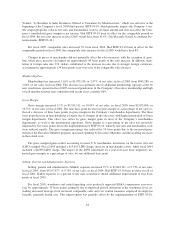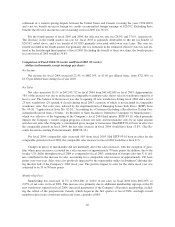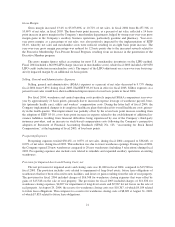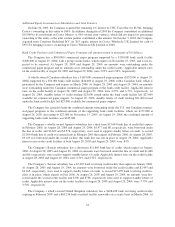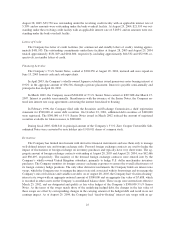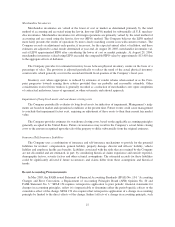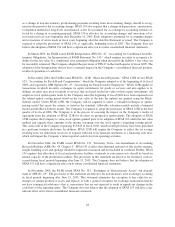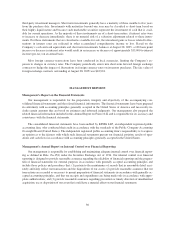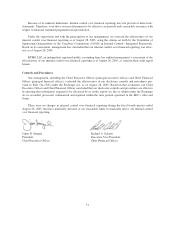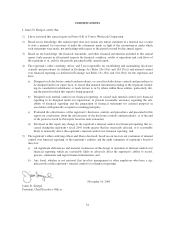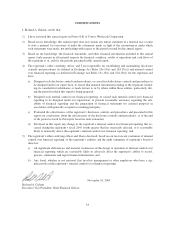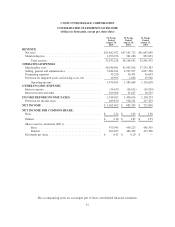Costco 2005 Annual Report Download - page 28
Download and view the complete annual report
Please find page 28 of the 2005 Costco annual report below. You can navigate through the pages in the report by either clicking on the pages listed below, or by using the keyword search tool below to find specific information within the annual report.Merchandise Inventories
Merchandise inventories are valued at the lower of cost or market as determined primarily by the retail
method of accounting and are stated using the last-in, first-out (LIFO) method for substantially all U.S. merchan-
dise inventories. Merchandise inventories for all foreign operations are primarily valued by the retail method of
accounting and are stated using the first-in, first-out (FIFO) method. The Company believes the LIFO method
more fairly presents the results of operations by more closely matching current costs with current revenues. The
Company records an adjustment each quarter, if necessary, for the expected annual effect of inflation, and these
estimates are adjusted to actual results determined at year-end. At August 28, 2005, merchandise inventories val-
ued at LIFO approximated FIFO after considering the lower of cost or market principle. At August 29, 2004,
merchandise inventories valued using LIFO exceeded the comparable FIFO value by approximately $13,410 due
to the aggregate effects of deflation.
The Company provides for estimated inventory losses between physical inventory counts on the basis of a
percentage of sales. The provision is adjusted periodically to reflect the trend of the actual physical inventory
count results, which generally occur in the second and fourth fiscal quarters of the Company’s fiscal year.
Inventory cost, where appropriate, is reduced by estimates of vendor rebates when earned or as the Com-
pany progresses towards earning those rebates provided they are probable and reasonably estimable. Other
consideration received from vendors is generally recorded as a reduction of merchandise costs upon completion
of contractual milestones, terms of agreement, or other systematic and rational approach.
Impairment of long-lived assets and warehouse closing costs
The Company periodically evaluates its long-lived assets for indicators of impairment. Management’s judg-
ments are based on market and operational conditions at the present time. Future events could cause management
to conclude that impairment factors exist, requiring an adjustment of these assets to their then-current fair market
value.
The Company provides estimates for warehouse closing costs, based on the applicable accounting principles
generally accepted in the United States. Future circumstances may result in the Company’s actual future closing
costs or the amount recognized upon the sale of the property to differ substantially from the original estimates.
Insurance/Self Insurance Liabilities
The Company uses a combination of insurance and self-insurance mechanisms to provide for the potential
liabilities for workers’ compensation, general liability, property damage, director and officers’ liability, vehicle
liability and employee health care benefits. Liabilities associated with the risks that are retained by the Company
are not discounted and are estimated, in part, by considering historical claims experience and outside expertise,
demographic factors, severity factors and other actuarial assumptions. The estimated accruals for these liabilities
could be significantly affected if future occurrences and claims differ from these assumptions and historical
trends.
Recent Accounting Pronouncements
In May 2005, the FASB issued Statement of Financial Accounting Standards (SFAS) No. 154, “Accounting
Changes and Error Corrections, a Replacement of Accounting Principles Board (APB) Opinion No. 20 and
FASB Statement No. 3.” SFAS 154 requires retrospective application to prior periods’ financial statements for
changes in accounting principles, unless it is impracticable to determine either the period-specific effects or the
cumulative effect of the change. SFAS 154 also requires that retrospective application of a change in accounting
principle be limited to the direct effects of the change. Indirect effects of a change in accounting principle, such
27



